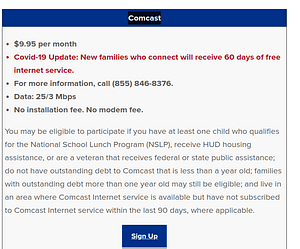
Dear Ms. Smartphone: For the rest of this school year my son (grade 11) will take high-school classes at home via computer. We live in an urban area, and while we don’t have the same issues as another nearby public school, we worry about the inequities. Many of my son’s friends are on teams at that other school, and these kids (used to) hang out at my house. Of course, everyone is at home now. I worry that these kids will fall behind if they cannot get online and complete the school year like we can. Dionne, Albany
Dear Dionne: School districts everywhere are having a difficult transition. It is not just about changing the curriculum from classroom to digital instruction so that students cover the requisite material and graduate on time. It is also about maintaining cybersecurity and student privacy, and, as you intuit, providing each student with digital access and electronic devices.
Internet for All:
At the beginning of the Internet (The Information Super Highway) there was concern over the digital divide: would the less privileged fall behind? Two things turned the tables (maybe more too). The ability to access the internet jumped from computers to smartphones. For nearly a decade anyone with an inexpensive smartphone and WiFi has access to the full Internet: e.g. job searches, tutorials, Wikipedia, maps, etc. A data plan is not a necessity. But, a FCC policy called Lifeline service, introduced in 1985, makes data available too. With Lifeline, eligible households get a discount for wireless service, broadband internet access and broadband voice bundles.
Today, ninety-five percent of teens say they have access to smartphones, and they can use them to find hotspots in novel, creative ways that run circles around their elders. Phones now have the capacity to carry television broadcasts (Quibi), so why not school lessons? I am not recommending that kids permanently follow their teachers on a smartphone, but it could be a make-shift solution, particularly if they dial-down two-way video. During the quarantine, almost all telcos and internet service providers have waived monthly data limits. Still, we can help kids identify places that offer social distancing and WiFi together, like library parking lots.
Common Sense Media Means Education:
There is a trove of information to be found on Common Sense Education. They thought about this long before the current crisis and have a seminal 2019 report called “The Homework Gap…Teacher Perspectives on Closing the Digital Divide.” For the current times, they provide a list of free and low-cost internet offers. When I put in an Albany zip code, it returned three “free” offers for Internet service (see image). Common Sense Education also points to a site called pcsforpeople where you can donate your old computer and have it refurbished for eligible individuals and non-profits. (Full disclosure: the website had fulfillment delays on 4/9/19).
If your son’s friends live in a more rural part of the state they might be experiencing difficulties getting full connectivity and fast-enough speeds to stream their school lessons. In more urban areas like yours, students, educators, and parents need to search out where there is existing broadband access, and they might discover it to be within their own home or apartment.


Leave a Reply
You must be logged in to post a comment.